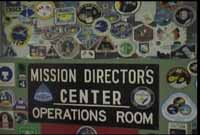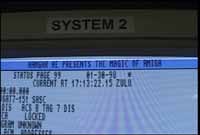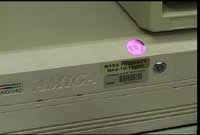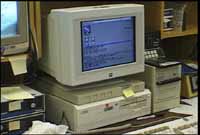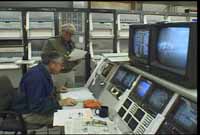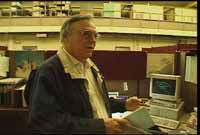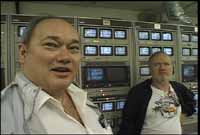|
A SHORT INTERVIEW WITH HAL GREENLEE (NASA RETIRED)
| [J.T.] Joachim Thomas - [H.G.] Hal Greenlee | |||
| [J.T.] | What other computer systems (if any) are at present used together with the Amigas at the telemetry center? (In the article you wrote that the only PC, time ago, was replaced by an Amiga and the software recompiled. May be today the PC would have been more efficient. Or not? Are Amigas more relyable? | |||
| [H.G.] | The telemetry center uses only Amigas to process data for display. It also
uses them to control the patching of DAC's (digital-to-analog converters) to
the 500 or so channels on strip chart recorders.
The Pentium or G3 might be more powerful, but the AmigaDOS multi-tasking
system and the use of 68K code (familiar to and liked by our programmers) were
important reasons the Amigas were favored originally. Neither Windows nor
Mac OS are or were considered suitable. Linux or some form of UNIX on one of
those CPU's might be better today. The Amigas have been very reliable.
| |||
| Photo |
| |||
| [J.T.] | How many Amigas are still there? Are there other departments at NASA also using (or that used in the past) Amigas, as far as you know? | |||
| [H.G.] | There were eight main system Amigas at my last count; four primary and four backup. Then there were four or five for DAC control, and four in the programming room. Plus about six or seven in remote locations, and another four or five spares on the shelf. | |||
| Photo |
| |||
| [J.T.] | What has changed at Cape Canaveral's telemetry labs computer systems from the time you wrote you article? Some more Amigas or some other machines replacing Amigas? | |||
| [H.G.] | Not too much has changed since I wrote the article; another couple of remotes; addition of PPC card to one computer, and several more PPC cards have been purchased. Still no code written for PPC, however. New, improved I/O cards. Minor things I may not be aware of. Dave Brown, the principle programmer, retired over a year ago, and the other two have been kept very busy to keep up with the workload. Little has been done on conversion to Pentium PC operation. | |||
| [J.T.] | Are there also other important launch sites of NASA (managed from elsewhere) using different equipment, excluding the manned missions, like shuttle? (or maybe using a similar computer network?) | |||
| [H.G.] | There are only the Western Test Range and Wallops Island launch sites, aside from the Cape. We have a smaller version of the Cape Amiga systems at the WTR in California. We have no connection with Wallops (sounding rockets), and know of no certain use of Amigas at other (non-launch) NASA centers, except at Lewis Research Center (Cleveland), where the Atlas-Centaur offices have a system provided by us. | |||
| Photo |
| |||
| [J.T.] | You wrote that, in the beginning, a lot of Hardware developmenthas been done also by NASA engineers, collaborating with third party developers. Any recent development/project? Are they at the present collaborating with anyone developing Hardware for the Amiga? Any interest for new developments like G3/G4 Boards and possibilities in collaborating with existing Hardware teams? | |||
| [H.G.] | Our hardware development was not extensive; the main things were I/O cards,
to get data into and out of the Amigas from our data bus. These have been
improved several times. I came up with a SCSI solution for our earliest
systems, based on work by an ex-Byte-by-Byte engineer, and we may have had
some of the earliest Amigas running with SCSI drives back in 1987. Also,
we used Bernoulli cartridge drives from early days, soon after we had SCSI
working.
There are no present or contemplated development projects with 3rd parties. | |||
| [J.T.] | Never had contacts with Amiga Inc? Does AInc know about NASA+Amiga? Any interest on any side? | |||
| [H.G.] | AI does know about us; they like
to bring it up in the right places. When Commodore was alive, I served as Commercial Developer and attended all DevCons; I developed as many contacts with C= and 3rd party companies as I could. When I retired, at the same time Commodore went down, that all stopped. Everything since then has been by email, newsgroups, or my attendance at shows and bringing back info. | |||
| [J.T.] | Is there any Web Site/Page about the telemetry center anywhere in NASA's Web Server Network, referencing also the Amiga systems? I know once there was your Space Coast Amiga Group site (I can't find it anymore...:-( ) was this site related with Amiga's involvement in NASA? | |||
| [H.G.] | There is no web page specifically about Hangar AE and Amigas. KSC pages do mention our operation in general terms, as I recall. | |||
| [J.T.] | What are you doing know, as a
NASA retired ? Are you still informed about what is going on in the Amiga scene (including Harware developments)? Do you usually read Magazines and/or online-magazines? Which, of both, are your favourites? | |||
| [H.G.] | I have been an Amiga dealer since November 1994 (seven months after retiring),
and have continued to go to shows in Germany, Canada, and St. Louis, as well
as reading the newsgroups daily. My company is HardDrivers Co., and I
specialize in second-hand systems and parts. We have sold almost half a
million dollars in Amiga equipment thus far.
That's all I have time for at present; leave for St. Louis on Thursday. HAL | |||
| Credits |
| |||




